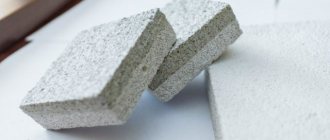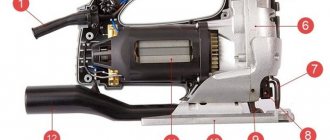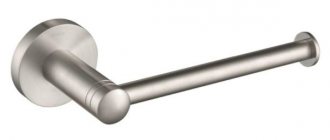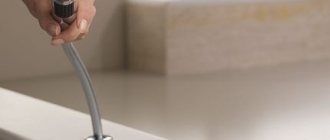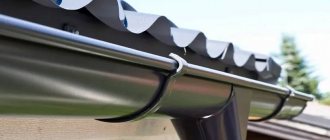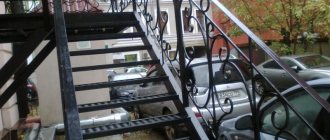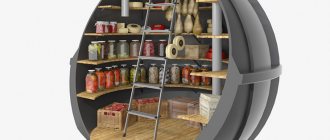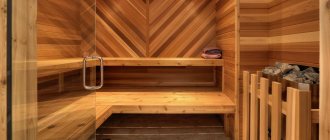Storm drainage is designed to drain water from the local area that gets there naturally with natural precipitation (rain and snow). Any drainage system is based on special containers through which water flows. Trays for storm drainage vary in size and material; they are used to install one complete drainage structure on a suburban area.
Linear storm drain
How does the drainage system work?
A drainage system is a system for collecting and draining rain, melt and groundwater to a specially designated place. Drainage systems are divided into the following types:
- surface - those through which rain and melt water is collected and later transported to the storm sewer;
- deep - designed for collecting and draining groundwater.
Drainage trays are part of the surface drainage system. In addition to them, storm water inlets and sand traps are used. As a rule, a drain drains water into a storm drain, a regular sewer system or a pond, but some enterprising summer residents direct the collected water to the beds. This is a practical solution, but it will be justified if there are heavy rainfalls - this is very rare in the region, otherwise a strong flow of water can wash out the soil and harm the plants.
Trays are made from different materials. Typically plastic, concrete and metal are used. It is advisable that the top of the tray be covered with a grill, which protects the system from large debris and, consequently, from clogging. The tray can be U- or U-shaped. When choosing a drainage tray, first of all, attention is paid to the material of its manufacture, therefore we will start with this characteristic.
Where used, design features
Drainage trays have a wide range of applications. They are installed:
- along roads, sidewalks and alleys;
- around sites of various types and suburban areas;
- around buildings and structures, airfields, parking spaces.
The main task is to create a system of canals through which water will be drained.
Purely structurally, the tray for surface drainage is a U-shaped, U-shaped gutter. The cross-section is trapezoidal or triangle. Can be telescopic. The second element is a grid laid on top of the tray. Its task is not to allow debris to pass through, which could clog the drainage system, rendering its operation useless.
But even a grille cannot protect the channels one hundred percent. Therefore, they must be cleaned periodically. That is, the grates are removed and debris is removed by hand or with garden tools. After which the protection is placed in its place.
Surface linear drainage
Plastic drainage trays
Plastic trays are made from polypropylene and low-density polyethylene . the greatest popularity in private construction . Products differ in width (7-30 cm). To increase strength properties, stiffeners can be used. Such reinforced gutters are perfect for arranging areas near garages, parking lots and car service stations.
pros:
- price. Plastic trays are cheaper than all analogues;
- light weight, which ensures ease of transportation and installation;
- resistance to silting, since the surface of the tray is absolutely smooth;
- resistance to low and high temperatures, from -40 to +900C;
- relatively high resistance to aggressive substances that may enter the drain
Minuses:
- low strength, low resistance to mechanical loads, which imposes restrictions on the area of use.
Such products are perfect for arranging the territory of a country house, but if we are talking about a road or an industrial area, then it is better to take more reliable material. An alternative solution is to reinforce the plastic tray with a zinc plate. Otherwise, during a strong flood, such a gutter may be deformed or even moved out of place.
The plastic tray must be protected with a grate , otherwise the storm drain may become clogged with debris flowing from the area. The grate should be light, but at the same time durable. Products made of galvanized or stainless steel are ideal. The strength of the grating is chosen depending on where the drain is installed, since the loads will be different near a country house and a car service center.
Cast iron
In the production of cast iron trays, two grades of cast iron are used:
- cast iron with lamellar graphite grain;
- cast iron with spherical graphite grain.
This material is part of the product profile and its lattice. Considering the fact that cast iron is very susceptible to corrosion, finished structures are galvanized, but usually this procedure is performed optionally: the client can order a tray without a zinc coating.
Since cast iron has good resistance to longitudinal and transverse loads, products made from it are used in places where they will be subject to great forces.
Typically, cast iron trays are installed on runways, truck stops and other areas: the use of cast iron trays on private land is not justified from a financial point of view. Dimensions of typical cast iron products:
- length – no more than 0.5 m;
- width – no more than 0.2 m;
- lattice thickness – from 0.05 m;
- internal diameter – from DN 100.
Metal drainage tray
The strongest products are made from metal . Despite this undeniable advantage, such gutters are currently used extremely rarely. The main reason is susceptibility to corrosion. Of course, manufacturers apply a protective layer, but it does not always prevent rust, since the product will be in constant contact with water. In addition, metal is expensive, and everything about such gutters will be decent, which will significantly complicate independent installation.
Metal trays can be of the following types:
- cast iron They are used extremely rarely due to their high weight. But they have practically no analogues in strength. Such products are not used in private construction, but they can be seen at military bases and other military facilities;
- steel trays (stainless and galvanized) are slightly inferior in strength to cast iron ones, but when choosing the right size and proper installation, such gutters serve no worse. On the other hand, they are much lighter than cast iron, which means they are easier to install. The products are used for arranging park areas and roads where passenger cars travel.
When choosing, it is important to pay attention to the thickness of the metal, as well as the thickness of the protective layer, on which strength and durability directly depend.
Do-it-yourself drainage of the area around the house
If the distance is less than 1.5 m, then the bearing capacity of the soil decreases - it becomes waterlogged and saturated with water. This affects the settlement of the foundation and makes the construction of a basement or ground floor problematic.
To drain the area around the perimeter of the planned house, or better yet along the edges of the entire yard, they dig channels with a slight slope and organize drainage. The optimal width of such channels is 50-70 cm.
The depth is calculated in each case individually, since it depends on how much the groundwater level needs to be lowered. Drainage is laid as follows.
At a distance of 2-3 m from the house, dig a ditch with a depth equal to the base of the foundation. A 15-20 cm layer of clay is placed on its bottom, giving it the shape of a tray. Medium-sized stones are carefully laid on top, forming sides. Large stones are placed on top, forming a vault. Gravel or crushed stone 25-30 cm high is placed on it. Everything is covered with soil removed during excavation. Water will seep through the soil into the tray and flow in the desired direction.
Concrete and reinforced concrete trays
Concrete trays are widely used in almost all areas of construction, incl. and in private. The products are produced in different sizes and fit well with paving slabs.
pros:
- high strength comparable to cast iron products;
- low price;
- durability;
- relatively simple installation, even despite the weight of the products;
- the possibility of use with an aggressive composition of wastewater, however, when purchasing it will be necessary to specify the brand of concrete used, since some of them can literally dissolve under the influence of certain substances.
Minuses:
- weight, which complicates transportation;
- sensitivity to shocks, therefore transportation is carried out with extreme caution;
- the need to use special cutting equipment.
The throughput capacity of concrete gutters is average, since the material has an imperfectly smooth surface, and dirt particles can gradually settle on it.
It offers a wide range of drainage trays. On sale are products made of concrete, composite concrete, polymer concrete, plastic and fiberglass, as well as point drainage and drainage for facades and terraces. The company's employees will help you choose the most suitable products.
Installation
Installation of a drainage system consists of several stages. Compliance with all rules and requirements eliminates common mistakes that beginners often make. First of all, you will need to make calculations for the drainage system. This will help with the production of a detailed roof diagram, which will show all the angles and parameters of the slope.
DIY drainage installation guide:
- Do-it-yourself installation of a drain should begin by fixing the funnel at the corners of the building or in the center of the slope. After this, you can begin installing fasteners under the gutters.
- The mount should be installed at a distance that does not exceed two centimeters from the funnel. The clamps will act as holders.
- The liquid should flow freely to the funnels, so the gutter should be installed at a slight angle to the horizontal. For every meter of gutter, a slope of 3-4 mm must be observed. The tilt is checked using plumb lines or a level with a nylon thread.
- Based on the placement of the drainage funnel, the slope can go from the center to the edge or from one edge to the other.
- When all the clamps are secured to the slopes, you can begin inserting the gutters. Using connectors, the elements are joined to each other, to the funnel and corner-type adapters.
- Usually, the connectors come with a rubber seal that prevents water from seeping into the cracks. If the rubber band is not included, you will need to purchase it separately and install it in each connector. At a distance of two centimeters from the connector, you will need to install clamps.
- If the length of the gutter exceeds the required value, you will need to cut the part using a metal leg. This tool is used to work with any system, even if plastic parts are used.
- The cut area must be sanded. There should be no protruding pieces of material on the surface. After processing, the gutter should be installed in the mount.
- Then you need to start installing the drainpipe. Initially, special clamps are attached to the surface of the walls. The spacing of the clamps should be one meter. After fixing, you need to insert the pipe itself into them.
- In cases where the edge of the roof is located at a large distance from the walls, the use of a universal elbow will be required.
- The elbows make it possible to move the pipe to the wall and secure it properly. An ebb is installed at the bottom of the pipe, which should be directed away from the walls to allow water to flow into the drainage system, the well. To do this, you will need an equipped storm drain.
- A similar scheme is suitable for installing drainage systems made of plastic and metal.
- If there are trees near your home, your gutters may become clogged with leaves in the fall. If the leaves are not removed in a timely manner, during the first frost a dense lump will form, which will not allow water to drain from the roof. To avoid this situation, you will need to install special sheet catcher grids.
Polymer concrete trays
Polymer concrete trays combine the advantages of plastic and concrete products, but they are rarely used, which is associated with a fairly high cost. Products are made from plastic, sand and additives.
pros:
- smooth inner surface;
- durability up to 30 years;
- relatively light weight (less than concrete), therefore transportation and installation are easier;
- sufficient strength and wear resistance.
Minuses:
- price;
- the need for special equipment for installation.
Specifications
Polypropylene trays have a melting point of 160 degrees, frost resistance is maintained down to -54 degrees, and a density of 889 kg/m3. The weight of the modules reaches 9–14 kg.
Polypropylene is a synthetic substance obtained from the synthesis of propene. It has increased strength and elasticity, does not absorb moisture, pushing it away from the surface, which increases the throughput of the modules. The material is resistant to most chemical compounds, non-toxic, and easily mixed with dyes. The use of plastic products allows us to minimize labor and material costs, which is reflected in their cost.
Composite drainage trays
Composite, or rather composite concrete, gutters are a more advanced version of concrete drainage trays. In addition to concrete, the composition contains composite additives that make it possible to obtain a material with unique characteristics.
pros:
- light weight and easy to transport;
- simple installation;
- high throughput;
- durability is higher than that of concrete analogues;
- possibility of mechanical cleaning;
- resistance to low temperatures;
- anti-vandal properties.
Minuses:
- price.
Fiberglass drainage systems (fiberglass)
One of the most modern solutions that has an amazing set of advantages. The tray is made on the basis of polystyrene, which is reinforced with fiberglass. Unlike conventional plastic gutters, which are designed for light loads, fiberglass analogues can be used even on busy roads, near enterprises and warehouses.
pros:
- versatility. Trays can be used in almost all areas of construction, incl. and in private;
- minimal weight and ease of transportation;
- ease of installation;
- durability;
- smooth surface;
- resistance to temperature changes, freezing and defrosting;
- not very high price.
Minuses:
- It is still inferior in strength to concrete, therefore it cannot be used on sites where the loads will be maximum (military bases, airfields, etc.).
Permissible load
Depending on the permissible load on the tray, they are divided into the following groups:
- A15 - trays that are installed in places with low mechanical and storm loads. Suitable for the local area in a country house, for garden paths, sports grounds;
- B125 - more durable products, suitable for installation along roads along which passenger cars travel;
- C250 can withstand even heavier loads and can be used in a car service center and car wash;
- D 400 – trays that can withstand the load from a vehicle of any weight, therefore they are suitable for installation on any roads, as well as in industrial zones;
- E600 are used near industrial enterprises and warehouses;
- F 900 are the most powerful trays that are necessary for equipping airports and military facilities.
Plastic trays belong to group A15-C250, fiberglass - A15-E600, and concrete and cast iron products can withstand maximum loads.
Recommendations for the operation of storm drains
Surface drainage systems must be periodically cleaned of debris that has entered them. For this purpose, the following cleaning methods are most often used:
- mechanical cleaning of trays using improvised means. It involves removing and reinstalling the grilles;
- hydrodynamic cleaning with water pressure under pressure. In this case, only one grid is removed to insert the hose into the channel. The water rushes through the canal, washing away all the garbage. It is carried out using fire fighting equipment or special devices that create high water pressure.
There are also other methods of cleaning storm drains, which are used less frequently, mainly to clear ice from channels. Thermal cleaning involves pumping hot water into the ducts, while chemical cleaning uses chemicals to remove layers of ice. However, the last two methods are not so popular.
Advice: In order not to spend a lot of effort cleaning already clogged drainage systems, take timely care of storm drains by performing regular preventive cleanings throughout the year.
A drainage system assembled in accordance with all the rules will ensure high-quality surface drainage of the area around the house for many years.
What else to consider when choosing?
When choosing drainage trays, also consider the following:
- throughput , i.e. the volume of water that the system, including drainage trays, can receive and discharge per unit of time. The larger the tray, the higher the throughput. When selecting, it is worth taking into account the intensity of precipitation in the region, the characteristics of the territory (this is the area adjacent to the house, where it is usually dry, or the area in front of the car wash), and the area of the catchment area. It is also important to take into account the parameters of discharges into storm sewers so that the drains do not become overcrowded. You can calculate the capacity of trays using special programs or by contacting specialists;
- tray dimensions calculated using a formula, taking into account the volume of precipitation, area of the site and drainage coefficient, depending on the type of coating;
- depending on the characteristics of the territory are purchased universal (discharge large volumes of water, often used in private construction), wear-resistant (copes with the removal of constantly large amounts of water) or deep drainage trays (optimal for low-lying areas, characterized by increased throughput).
Installation rules
Laying plastic trays does not involve any specific nuances, so the installation technology is quite simple even for the average person who does not have practical experience in arranging a moisture drainage system. First of all, you should study in detail the drainage system diagram and take the necessary measurements. Plastic trays are selected taking into account the type of soil where the products are expected to be installed.
Having decided on the characteristics of the environment where the structure will be used, it will be quite simple to select the required tray size and the required level of product throughput.
For installation you will need the following products and tools:
- trays with bars;
- concrete solution;
- shovel and hacksaw;
- saw, hammer, acrylic sealant.
Most often, a drainage system is installed around the perimeter of a building located on the territory, however, this is not at all necessary. When starting to dig a trench, it is worth considering the need to create a concrete pad at the bottom. When laying the trays, it is necessary to take into account that the grate should be located slightly below the base level, approximately 5–6 cm. After completing the work to create the trench, a concrete cushion is poured into it, the height of which should be at least 10 cm.
Drainage trays are laid in the center of the channel, covered with gratings and covered with film in order to remove excess concrete around the edges. Concrete supports are cast between the tray and the walls of the channels. At the corner joints of the elements, the resulting gaps in the fastenings are treated with sealant.
When installing a drainage system over which asphalt will subsequently be laid, all channels should be covered with fiberboard. With regular cleaning and inspection of the moisture removal system, a well-equipped structure can last for decades.
To learn how to install drainage plastic trays with your own hands, see the following video.

